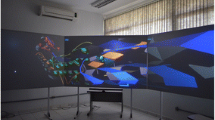Abstract
Digital home application market shifts just about every month. This means risk for developers struggling to adapt their applications to several platforms and marketplaces while changing how people experience and use their TVs, smartphones and tablets. New ubiquitous and context-aware experiences through interactive 3D applications on these devices engage users to interact with virtual applications with complex 3D scenes. Interactive 3D applications are boosted by emerging standards such as HTML5 and WebGL removing limitations, and transforming the Web into a real application framework to tackle interoperability over the heterogeneous digital home platforms. Developers can apply their knowledge of web-based solutions to design digital home applications, removing learning curve barriers related to platform-specific APIs. However, constraints to render complex 3D environments are still present especially in home media devices. This paper provides a state-of-the-art survey of current capabilities and limitations of the digital home devices and describes a latency-driven system design based on hybrid remote and local rendering architecture, enhancing the interactive experience of 3D graphics on these thin devices. It supports interactive navigation of high complexity 3D scenes while provides an interoperable solution that can be deployed over the wide digital home device landscape.







Similar content being viewed by others
Notes
Html5 standard specification (May 2011) http://www.w3.org/TR/html5/
Webgl website (Mar. 2011) http://www.khronos.org/webgl/
HbbTV 1.5 specification (April 2012) http://www.hbbtv.org
Cascading style sheets (css) standard specification (May 2011) http://www.w3.org/TR/CSS/
May 2012. IMS Research
Kang, T.: Global smartphone vendor market share: Q3 2012. International Data Corporation (Oct. 2012)
Mawston, N.: Global tablet vendor market share: Q3 2012. Strategy Analytics (Oct. 2012)
Market Trends: Mobile App Stores, Worldwide. Gartner (Sept. 2012)
Html5 standard specification (May 2011) http://www.w3.org/TR/html5/
Cascading style sheets (css) standard specification (May 2011) http://www.w3.org/TR/CSS/
Phonegap website (Jan. 2012) http://www.phonegap.com
Webgl website (Mar. 2011) http://www.khronos.org/webgl/
March 2012. IP&TV World Forum in London
March 2012. http://www.espial.com/company/press_item/id745
References
Anttonen M, Salminen A et al (2011) Transforming the web into a real application platform: new technologies, emerging trends and missing pieces. In: Proceedings 2011 ACM symposium on applied computing, pp 800–807
Azuma R (1997) A survey of augmented reality. In: Presence: Teleoperators and Virtual Environments, vol 6, no 4, pp 355–385
Butler M (2011) Android: changing the mobile landscape. IEEE Pervas Comput 10(1):4–7
Daras P, Alvarez F (2009) A future perspective on the 3D media internet. In: Towards the future internet: a European research perspective. IOS Press, Amsterdam, pp 303–312
Fechteler P, Eisert P (2010) Accelerated video encoding using render context information. In: IEEE 17th International conference on image processing (ICIP) 2010, pp 2033–2036. doi:10.1109/ICIP.2010.5651183
Hofmann I, Farber NFH (2011) A study of network performance with application to adaptive http streaming. In: BMSB 2011 IEEE international symposium
Humphreys G, Eldridge M, Buck I, Stoll G, Everett M, Hanrahan P (2001) Wiregl: a scalable graphics system for clusters. In: Proceedings of the 28th annual conference on computer graphics and interactive techniques, SIGGRAPH ’01. ACM, New York, pp 129–140. doi:10.1145/383259.383272
Humphreys G, Houston M, Ng R, Frank R, Ahern S, Kirchner PD, Klosowski JT (2002) Chromium: a stream processing framework for interactive rendering on clusters. ACM Trans Graph (TOG) 21(3):693–702
Laikari A, Laulajainen JP et al (2009) Gaming platform for running games on low-end devices. In: Proceedings of ICST personalization in media delivery platforms, p 4
Lamberti F, Sanna A (2007) A streaming-based solution for remote visualization of 3d graphics on mobile devices. IEEE Trans Vis Comput Graph 13(2):247–260
Lu Y, Li S, Shen H (2011) Virtualized screen: a third element for cloud mobile convergence. Multimedia IEEE 18(2):4–11
Marino G, Gasparello P, Vercelli D, Tecchia F, Bergamasco M (2010) Network streaming of dynamic 3d content with on-line compression of frame data. In: Virtual reality conference (VR), 2010. IEEE, pp 285–286. doi:10.1109/VR.2010.5444762
Moreno C, Tizon N, Preda M (2012) Mobile cloud convergence in gaas: a business model proposition. In: Hawaii international conference on system sciences, pp 1344–1352
Nadalutti D, Chittaro L, Buttussi F (2006) Rendering of x3d content on mobile devices with opengl es. In: Proceedings of the eleventh international conference on 3D web technology, Web3D ’06. ACM: New York, NY, USA, pp 19–26. doi:10.1145/1122591.1122594
Ortiz S (2010) Is 3d finally ready for the web? Computer 43(1):14–16
Ortiz S Jr (2011) Bringing 3d to the small screen. Computer 44(10):11–13
Rainer B et al (2012) A seamless web integration of adaptive http streaming. In: Proceedings of the 20th European signal processing conference 2012. Bucharest, Romania
Shi W, Lu Y, Li Z (2010) Scalable support for 3d graphics applications in cloud. In: IEEE 3rd International conference on cloud computing, p 8
Simoens P, De Turck F, Dhoedt B, Demeester P (2011) Remote display solutions for mobile cloud computing. Computer 44(8):46–53
Taivalsaari A, Mikkonen T (2011) The death of binary software: and user software moves to the web. In: Ninth international conference on creating, connecting and collaborating through computing, pp 17–23
Taivalsaari A, Mikkonen T (2011) The web as an application platform: the saga continues. In: 37th EUROMICRO conference on software engineering and advanced applications, pp 170–174
Tarkoma S, Lagerspetz E (2011) Arching over the mobile computing chasm: platforms and runtimes. Computer 44(4):22–28
Zahariadis T, Daras P, Laso-Ballesteros I (2008) Towards future 3d media internet. In: NEM Summit 2008. St. Malo, 13–15 October 2008
Zorrilla M et al (2012) Next generation multimedia on mobile devices, mobile technology consumption: opportunities and challenges. IGI Global. doi:10.4018/978-1-61350-150-4.ch011
Zorrilla M et al (2012) End to end solution for interactive on demand 3d media on home network devices. In: BMSB 2012 IEEE international symposium, pp 1–6
Acknowledgements
The authors would like to thank the Spanish Ministry for Industry, Tourism and Commerce, and the European FEDER funds for supporting the research activities involved in this paper.
Author information
Authors and Affiliations
Corresponding author
Rights and permissions
About this article
Cite this article
Zorrilla, M., Martin, A., Sanchez, J.R. et al. HTML5-based system for interoperable 3D digital home applications. Multimed Tools Appl 71, 533–553 (2014). https://doi.org/10.1007/s11042-013-1516-7
Published:
Issue Date:
DOI: https://doi.org/10.1007/s11042-013-1516-7




